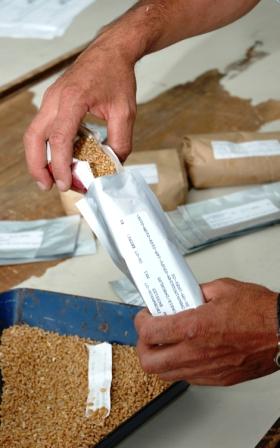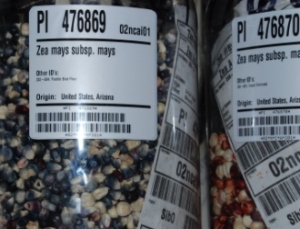Storage of maize genetic resources
Contributors to this page: CIMMYT, Mexico (Suketoshi Taba), with inputs also received from IITA, Nigeria (Dominique Dumet), EMBRAPA (maize and sorghum genebank), Brazil (Flavia Teixeira), USDA(ARS/NC7, ISU), USA (Mark Millard).
|
Contents: |
A base collection is a form of long-term storage. The initial population is used as a bench mark for monitoring changes in genetic diversity over time and after several cycles of regeneration due to genetic drift. It should ensure that seed viability and seed availability of the accessions in the genebank remain at acceptable levels for at least 50 years, which would be one regeneration cycle of a maize genebank accession. It is also used as a back up when the active collection samples are no longer available.
When it should be used
 Seeds going into foil bags at CIMMYT (photo: CIMMYT) |
The function and operation of the base collection should be supported in the long term through core funding of the institution or government.
The base collection serves the following purposes:
- As a duplicate and safety collection of the active collection for long-term conservation.
- To reduce the number of regeneration cycles for conservation of the genetic integrity of accessions.
- To provide the foundation seed for regeneration of the accessions.
- As a black-box seed storage for safety deposits of the cooperative genebanks.
Sample specifications
To conserve as many accessions as possible in a cost effective manner.
Minimum sample size for storage
- Normal genebank sample size of maize is 1.5-2 kg (2500-3500 seeds).
- Minimum sample size could be 500 g or several regeneration sets (one set is 256-512 seeds).
Minimum viability for storage
- The initial viability of the accessions should be more than 95% and it should certainly not be less than 85%. .
Moisture content
Important to maintain seed viability for long term conservation.
- The seed moisture content should be balanced at 6-8% in cool drying rooms before packaging the seed samples..
Container specifications
Seed packaging method
To pack the seeds in impermeable pouches and to reduce seed metabolism to a minimum.
- Aluminum foil side-gusseted stand-up pouches (one or two pouches) should be filled with the dried seed samples and sealed by a pressured sealer with heat.
- Packages should be re-sealable and impermeable to air and moisture (for example, use PI Impulse heat sealer, “PAC” PACKAGING AIDs Cooperation, CA, USA).
- Other laminated foil types under vacuum can also work (as is the case in IITA).
Specifications of packaging material
- Stand-up custom-made side-gusseted pouches made of aluminum foil (size 3.5” x 10.5” x 1.25”; expand to 2.5”). These can be supplied by KAPAK Corporation, 5303 Parkdale drive, Minneapolis, MN 55416-1681, USA. .
Storage specifications
Assigning location codes
To facilitate access to the seed accessions stored in the genebank.
-
The seed accessions should be stored in an orderly fashion.
- The row, column, level and box (sample within box) in the storage racks should be identified by two-digit numbers.
- A prefix can be placed to denote row, column, level, box and sample numbers.
- For example: R01C01L01B01S01 or R12C06L12B12S05.
Storage conditions
To ensure longevity of the seed viability.
- As stated in the genebank standards (FAO/IPGRI 1994), storage at less than -18oC is preferred but -20oC is also often used.
An active collection is a medium-term storage. Its purpose is to conserve a large quantity of seeds per accession in order to meet seed requests, as well as to be used for research and enhancement by the genebank. The active collection preserves the germplasm accessions for at least 20 years or for a half of one regeneration cycle in the base collection, as the cost of the regeneration of maize accessions is expensive. (Click for more information on the costs of regeneration from CIMMYT)
When it should be used
The active collection serves to:
- Conserve the accessions actively used or expected to be used such as elite lines and populations, core subsets and reference seeds sets of all accessions for management of the genebank.
- Distribute seed samples to the users.
- Store new introductions and the regenerated seeds before inventorying them.
- Store ear and seed samples of the representative germplasm diversity for research and enhancement.
Sample specifications
To make seed samples available to meet the seed requests.
Minimum sample size for storage
- Normal sample size in the active collection is 2-3 kg (4000-6000 seeds).
- Minimum size is 500 g or several sets of the seed shipment packets of 50 or 100 seeds.
Minimum viability for storage
- Seed viability is above 85%.
Moisture content
To maintain seed viability for more than 20 years in active collection.
- Preferred moisture content is 6-8%.
- In some genebanks, 8-10% seed moisture is common in the active collection.
|
Labeled jars of maize in the USDA genebank in Ames, USA. |
.jpg) Storage of maize seeds in plastic containers (photo: CIMMYT) |
Container specifications
Airtight, thick plastic transparent containers protect the seeds from absorbing moisture and can hold sufficient amounts of seed. They are also handy to access and retrieve seed samples. Containers should have bar code labels inside and outside the container for efficient record-keeping.
Seed packaging method
- An airtight, thick plastic container or canister with a lid that can open and close easily.
- Steel cans should not be used, as they become rusty with the moisture that forms outside the cans when they are removed from the cold storage.
- Glass jars with an airtight lid can also be used.
Specifications of packaging material
- Airtight canisters of 3.8 litres (about 2-3 kg of maize seeds). The container should be large enough to hold 2-3 kg (3.9 litres) of seeds.
- An example: SNAPWARE, 120oz. square-grip plastic canister, 10.75” H x 4.75”w x 5.50”D, Mira Loma, CA, USA. (Email: This email address is being protected from spambots. You need JavaScript enabled to view it.).
Storage specifications
Assigning location codes
To provide easy access and retrieval of the seed accessions from the seed storage vault.
- Row, column, level and box (sample within the box) should be identified by two–digit numbers. Containers or glass jars should be stored in an orderly fashion.
Storage conditions
To ensure that seed viability in the active collection storage can last more than 20 years.
- It is preferable to store the active collection in medium-term conservation conditions.
- The temperature should be set between 0oC and 10oC with a relative humidity (RH) of 25-35% to ensure seed viability for more than 20 years.
- Low relative humidity in the storage room is more important for seed longevity than low temperature.
- In IITA, the temperature is set at 6oC and RH is at 25-30%.
Provides guidance on how to arrange the physical space, how to track seed material and record information during storage.
 Inside a genebank storage room (photo: CIMMYT) |
Storage space arrangement
It is very important to provide easy access to the accessions.
Room
- Use the minimum space possible (to reduce cost of cooling the storeroom), but allow convenient access to each sample.
Shelves
- Shelves can be constructed in a row and column arrangement for inventorying the samples in an orderly fashion.
- Movable racks are preferable, as they are designed to save space within the genebank.
- Fixed racks are also common, leaving space to access the seed samples.
- Each rack may have several levels, perhaps as many as 6-8, depending on the size of the seed container and box.
System for tracking materials/inventory system in seed banks
To provide efficient and effective access to the seed accessions.
- It is important to use a database to keep track of stock and location of material, and to use bar codes.
Recording information during storage
The following information must be recorded for each consignment:
- Accession number (number).
- Introduction ID number (number).
- Collection name, pedigree (name and number).
- Associate number (other genebank’s accession numbers).
- Collection site (country of origin, state name, longitude, latitude, altitude).
- Donor (donor institution).
- Race class (maize race, race purity, common name).
- Grain type (texture, colour).
- Origin of the stored seeds (location, year, field plot, sample).
- Photo [sample photo of ear and/or kernels (grain type: colours and textures)].
- Reference sample (location in the bank, seed origin).
- Seed exchange policy (MLS, specific).
- Seed health (cleared for outgoing, not cleared).
- Seed shipment (collaborator, institution, country).
- Safety duplicate storage information (collaborating genebanks).
- Seed monitoring (seed amounts and seed viability).
- Accession availability status (available, not available).
- Storage address (row-column-level-sample).
- Amount of seed stored (seed number or seed weight).
References and further reading
Brandolini A. 1970. Maize. in: Frankel OH, Bennett E, editors. Genetic Resources in Plants: Their Exploration and Conservation. F.A. Davis Co., Philadelphia. pp. 273-309.
Chang TT. 1985. Preservation of crop germplasm. Iowa State Journal of Research. Vol. 59. No.4. pp. 365-378.
Ellis RH. 1998. Longevity of seeds stored hermetically at low moisture contents. Seed Science Research supplement 1:9-10.
FAO/IPGRI. 1994. Genebank standards. Food and Agriculture Organization of the United Nations, Rome and International Plant Genetic Resources Institute, Rome. Available in English, Spanish, French and Arabic.
Pardey PG, Koo B, Wright BD, Van Dusen ME, Skovmand B, Taba S. 2001. Costing the conservation of genetic resources: CIMMYT’s ex situ maize and wheat collection. Crop Science 41(4):1286-1299. Available from : http://sgrp.cgiar.org/sites/default/files/Pardey-2001.pdf. Accessed: 15 September 2010.
Probert RJ, Hay FR. 2000. Keeping seeds alive. In: Black M, Bewley JD, editors. Seed technology and its biological basis. CRC Press LLC. USA and Canada. pp. 375-404.
Taba S, van Ginkel M, Hoisington D, Poland D. 2004. Wellhausen-Anderson Plant Genetic Resources Center: Operations Manual, 2004. El Batan, Mexico: CIMMYT. Available here.
Walters C, Wheeler LM, Grotenhuis JM. 2005. Longevity of seeds stored in a genebank: species characteristics. Seed Science Research 15:1-20.
Comments
- No comments found






Leave your comments
Post comment as a guest